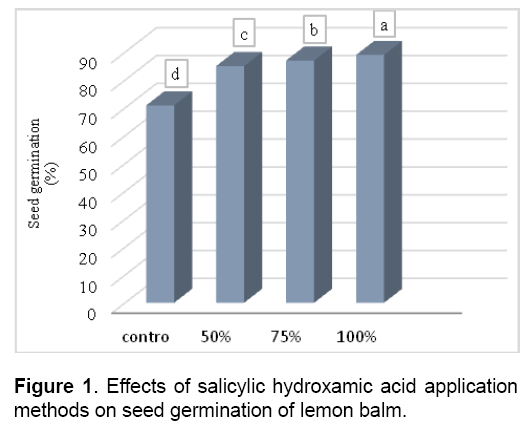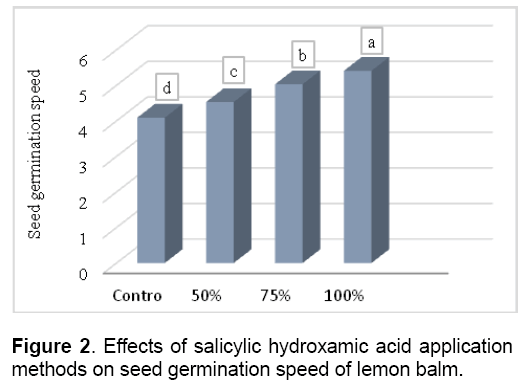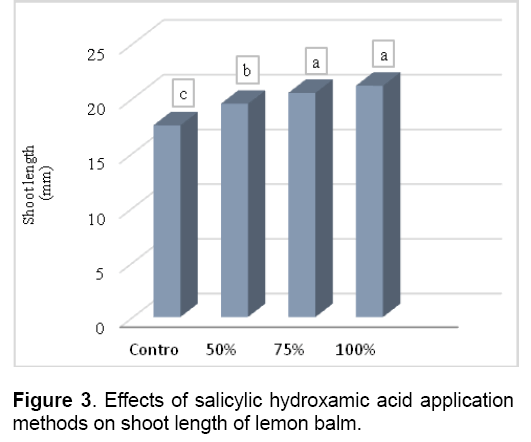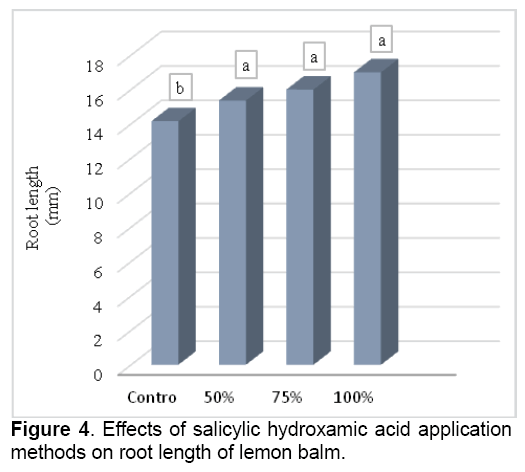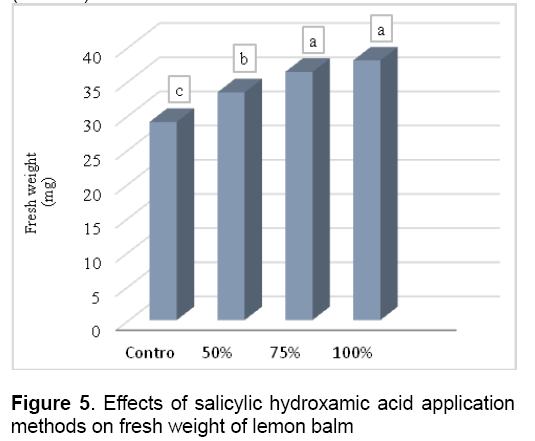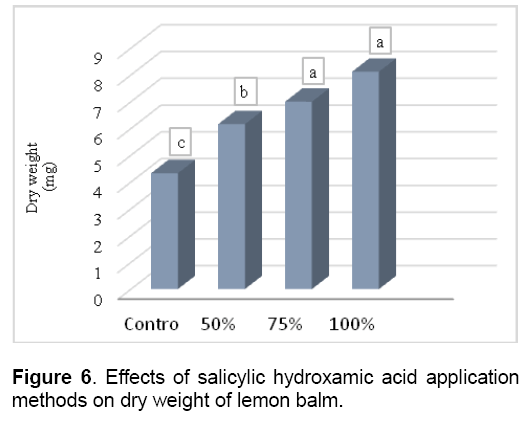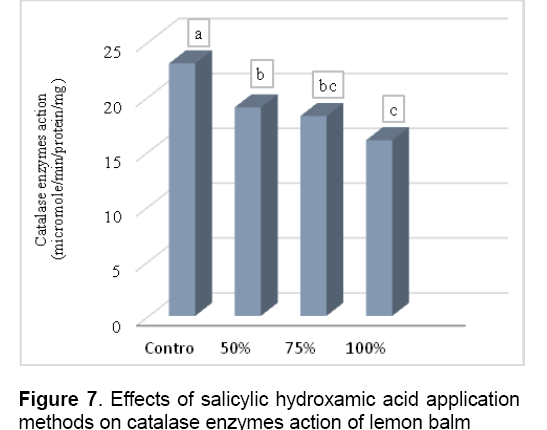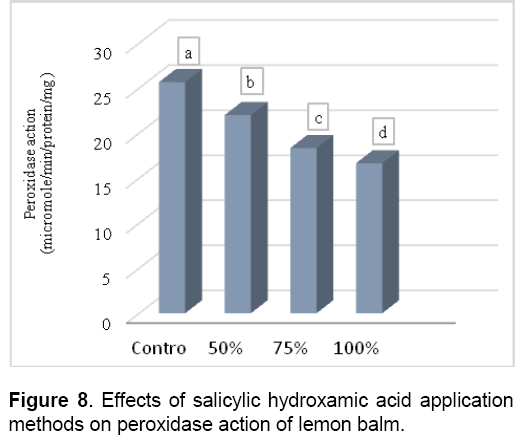Physiological and Morphological Response of Lemon Balm (Melissa officinalis L.) to Prime Application of Salicylic Hydroxamic Acid
Hamidreza Ardalani, Davood Eradatmand Asli , Pejman Moradi
Hamidreza Ardalani1,*,Davood Eradatmand Asli2 ,Pejman Moradi1
1Department of Horticultural Sciences,Saveh Branch,Islamic Azad University,Saveh,Iran
2Department of Agriculture,Payame Noor University,Tehran,Iran
Abstract
Lemon balm (Melissa officinalis L.), member of Lamiaceae family, is one of the important medicinal plant species. In this study we were investigated the effects of Salicylic hydroxamic acid(SHAM) on seed germination and yield of lemon balm. It was conducted at Agriculture Research Center of Hamedan Province in 2013. SHAM used in 4 different concentrations (0, 50, 75, 100 ppm). Seeds were primed for 8 hours in each concentration, and planted in petri dish. Then, we were assessment some parameter such as seed germination, germination speed, root length, root weight, shoot length, shoot weight, seedling dry weight, enzyme activity, catalase, and peroxidase. This study indicated that SHAM had significant effects on all germination traits and biochemical parameters. Comparison of mean effects of SHAM revealed that the highest germination percent (89%), germination speed (5.41), shoot length (21.15 mm), root length (17 mm), fresh weight (38 mg) and dry weight (8.12 mg). The highest catalase enzymes (23 micromole/mg) and highest peroxidase action (25.66 micromole/mg) were observed at the control concentration. It can be concluded that the SHAM has antioxidant properties and regulate resporiratory system.
Keywords
Salicylic hydroxamic acid; priming; germination; lemon balm (Melissa officinalis L.).
1. Introduction
Lemon balm (Melissa officinalis L.),member of Lamiaceae family,is a herbaceous,perennial herb that presents a lemon flavor [1]. Lemon balm,one of the important medicinal plant species mainly grown in natural flora especially in Mediterranian region,is native to southern Europe,Asia Minor,southern parts of North America,northern Africa,and east as far as the Caucasus and northern Iran [1,2,3]. In scientific classification is a perennial herb that is,one that lives at least three years. It is bushy and upright,reaching a height of about 1 m. The soft,hairy leaves are 2 to 8 cm long and either heart-shaped .The leaf surface is coarse and deeply veined,and the leaf edge is scalloped or toothed. White or pale pink flowers which consist of small clusters of 4 to 12 blossom in the summer. There are three subspecies of Melissa officinalis subsp. officinalis,subsp. inodona and subsp. altissima; however,only subsp. officinalis has a commercial value with characteristic lemony odor [4,5]. Lemon balm is used for several purposes such as an additive in food,a herb tea,an ingredient in cosmetics,an ornamental and a medicine. Essential oil is currently used in medicine and pharmacology (anti-tumor,anti-bacterial,antimicrobial,antihistaminic,antispasmodic and antioxidant,by means of its antiviral effect curing of the herpes,antiulcerogenic,moderate Alzheimer’s disease,modulation of mood and cognitive performance,stimulating the immune system (against anti HIV-1) [6,7]. There are several commercially available chemical compounds that could be used as elicitors to modify plant secondary metabolites and subsequently the bioactivity of medicinal plants. The most well-known chemical elicitors include salicylic acid [8]. Salicylic acid (SA) plays an important role in abiotic stress tolerance,and more interests have been focused on SA due to its ability to induce a protective effect on plants under adverse environmental conditions. SA may affect directly on specific enzymes function or may activate the genes responsible for protective mechanisms [9].
Afzal [10] reported that reduction of water absorption by seeds due to increase in osmotic pressure in salinity and drought stress have been reduced the physiological and metabolic processes. Gunes et al,[11] reported that SA could be used as a potential growth regulator to improve plant salinity tolerance. Shakirova et al,[12] reported soaking wheat seeds at a low concentration of salicylic acid (0.05 mM) for 3 hours activate germination.
This study aimed to evaluate physiological and morphological response of lemon balm (Melissa officinalis L.) to prime application of salicylic hydroxamic acid.
2. Materials and Methods
Plant materials,chemicals and instruments
In order to study the effects of salicylic hydroxamic acid application methods on seed germination and yield of lemon balm,an experiment was conducted at Agriculture Research center & Natural Resources of Hamedan Province in 2013.
Research Center is situated in Hamedan Province with the altitude of (34° 48 ′N and 48° 31 ′E with the height of 1671 m from the sea level),Hamadan province lies in a temperate mountainous region to the east of Zagros.
Salicylic hydroxamic acid in 4 different concentrations (0,50,75,100 ppm) in factorial based on randomized complete block design with three replications. Disinfected by sodium hypochlorite solution for 3 minutes. Next,the seeds were washed three times by distilled water. After that,the seeds were treated for 8 hours and at a temperature of 200 C in salicylic hydroxamic acid solutions with 50,75,and 100 ppm concentrations. Then,they were placed in petri dishes holding No.1 Watman filter papers. Next,they were put in the growth chamber with 8 hours of light and 240C.
After 14 days,petri dishes were taken out of chambers,and then activities of catalase enzyme along with peroxidase obtained from the plant extract were measured by spectrophotometer. In order to measure dry weight of stem,root,and seedling,the samples were kept in spectrophotometer for 2 days at a tem erature of 700C
In this study,such traits as percentage of seed germination,germination speed,root length,root weight,shoot length,shoot weight,seedling dry weight,enzyme activity,catalase,and peroxidase were measured.
Variance analysis
The experiment was arranged as a factorial in a completely randomized block design with three replications. Variance analysis test was used for analyses,while Duncan Test being employed for grouping of treatment means. Statistical analysis was performed using Minitab statistical software,and logarithms employed to transform the data. Means were compared using Duncan multiple range test at P≤0.05 Data analysis used EX EL
3. Results
Obtained results show that SHAM had significant effects on all germination traits and biochemical parameter at the possible level of 1% (Table 1).

3.1 Seed germination percent and seed germination speed
According to Figure 1,comparison of mean effects of salicylic hydroxamic acid application methods on seed germination of lemon balm revealed that the highest germination percent (89%) was obtained at the concentration (100 ppm) and the lowest germination percent (70.88%) was obtained at the concentration (control).
According to Figure 2 ,comparison of mean effects of salicylic hydroxamic acid application methods on seed germination speed of lemon balm revealed that the highest germination speed (5.41) was obtained at the concentration (100 ppm) and the lowest germination percent (4.09) was obtained at the concentration (control).
3.2 Shoot length and root length
According to Figure 3 ,comparison of mean effects of salicylic hydroxamic acid application methods on shoot length of lemon balm revealed that the highest shoot length (21.15 mm) was obtained at the concentration (100 ppm) and the lowest shoot length (17.53 mm) was obtained at the concentration (control).
According to Figure 4 ,comparison of mean effects of salicylic hydroxamic acid application methods on root length of lemon balm revealed that the highest root length (17 mm) was obtained at the concentration (100 ppm) and the lowest root length (14.16 mm) was obtained at the concentration (control).
3.3 Fresh weight and dry weight
According to Figure 5 ,comparison of mean effects of salicylic hydroxamic acid application methods on fresh weight of lemon balm revealed that the highest fresh weight (38 mg) was obtained at the concentration (100 ppm) and the lowest fresh weight (29 mg) was obtained at the concentration (control). According to Figure 6 ,comparison of mean effects of salicylic hydroxamic acid application methods on dry weight of lemon balm revealed that the highest dry weight (8.12 mg) was obtained at the concentration (100 ppm) and the lowest dry weight (4.33 mg) was obtained at the concentration (control).
3.4 Catalase enzymes action and peroxidase action
According to Figure 7 ,comparison of mean effects of salicylic hydroxamic acid application methods on catalase enzymes action of lemon balm revealed that the highest catalase enzymes (23 micromole/mg) was obtained at the concentration (control) and the lowest catalase enzymes (16 micromole/mg) was obtained at the concentration (100 ppm).
According to Figure 8 ,comparison of mean effects of salicylic hydroxamic acid application methods on peroxidase action of lemon balm revealed that the highest peroxidase action (25.66 micromole/mg) was obtained at the concentration (control) and the lowest peroxidase action (16.66 micromole/mg) was obtained at the concentration (100 ppm).
4. Discussions and Conclusion
Furthermore,germination rate went up with increased concentration at the possible level of 1%,in a way that germination rate was observed 5/41 at a concentration of 100 ppm and 4/09 in the control treatment. The differences among all treatments were significant (Figure 2 ).
Seed germination is a crucial stage in the life cycle of plants and tends to be highly unpredictable over space and time. Several environmental factors such as temperature,salinity,light,and soil moisture simultaneously influence germination [13]. Stem length also grew with increasing the concentration. The longest stem was observed in the 100 ppm treatment which was (21.15 mm) and the shortest was observed in the control treatment. This difference was significant at the possible level of 1%,but the difference between 75 and 100 ppm treatments wasn't significant (Figure 3 ). The greatest amount of change in other traits was observed in control and 50ppm treatments. It is possible that the cause of increase in percentage of germination following the application of different salicylic hydroxamic acid concentration is the effects on antioxidant systems and respiration regulators which are congruent with in terms of percentage of germination [14,15]. During seed priming water absorption and 1 are finished,but root doesn't start germination. After cultivation and completion of the first two phases of germination,seeds start to germinate rapidly and evenly. Benefits of this treatment include: increase in germination,more even and faster germination of seedlings,acceleration of maturation,wider temperature range for germination,repairing damaged cells,reducing barriers to growth of the fetus,increasing the quantity and quality of protein synthesis,removal of dormancy,increased tolerance to environmental stresses during planting and plant development [16]. Priming increases antioxidant enzymes such as glutathione and ascorbic which reduce activities of lipid peroxidation leading to increased germination. Common techniques include: osmopriming,hydropriming,and halopriming [17]. Moreover,alternative respiration was examined in seven types of Quercus in Spain and it was concluded that as concentration of SHAM and KCN increase,respiration rate decreases which leads to improved performance [18]. In the lowest concentration of 50 ppm,the highest amount of change was observed which indicates that hormone-like SHAM reduces oxidative activities inside the seed. These activities are further reduced with higher levels of concentration,but the lowest level of oxidative activities are controlled by 50ppm concentration. Chandra et al,[19] reported that application of salicylic acid increased total soluble sugar and soluble protein of cowpea plants. Ajmal khan et al,[20] reported the improvement and increase in germination by salicylic hydroxamic acids is achieved through releasing free radicals and active oxygen which is consistent with the current study findings. The mechanism of seed priming is to initiate the repairing system for membrane and the metabolic preparation for germination through controlling water absorption rate of seed [21].
It seems that the cause of increase in wet and dry weight of the seedling as a result of application of salicylic hydroxamic acid is related to what increases the length of root and stem by this hormone like. Since salicylic hydroxamic acid play a role in synthesizing particular proteins by the name of kinas which adjusts distribution and differentiation,morphogenesis of the cell. Decrease in cell membrane damage can also be accompanied with an increase in dry weight. Similar findings have been reported [22,23].
In conclude,plant secondary metabolites are unique sources for pharmaceuticals,food additives,flavors and other industrial materials. Accumulation of such metabolites often occurs in plants subjected to stresses including various elicitors or signal molecules. Salicylic acids compounds have long been observed to be transducers of elicitor signals for the production of plant secondary metabolites. Therefore,the result of this research shows that it is likely that the increase in the percentage of germination is due to the application of different concentrations of sali yli hydro ami a id and its effects on the antioxidant system,and the res iratory re ulators
References
- Mozaffarian V. (1998). A dictionary of Iranian plants names. Tehran: Farhang Moaser Publishers,pp. 547– 548.
- Burgett M. (1980). The use of lemon balm (Melissa officinalis) for attracting honeybee swarms. Bee World,61: 44-46.
- Craker L.E.,Simon J.E. (1992). Herbs,Spices,and Medicinal Plants: Recent Advances in Botany,Horticulture,and Pharmacology. Volume 2. Oryx Press. USA.
- Davis P.H. (1982). Flora of Turkey and the East Aegean Islands. Edinburgh University Press,7: 262-264.
- Anonymous. (1996). British Herbal Pharmacoppeia (BHP). Exeter,U.K.: British Herbal Medicine Association: 29-30.
- Allahverdiyev A.,Duran N. et al. (2004). Antiviral activity of the volatile oils of Melissa officinalis L. against herpes simplex virus type-2.,Phytomedicine,11: 657-661.
- SarÃÆââ¬Å¾Ãâñ A O ,eylan A (2 2) Yield hara teristi s and Essential oil composition of lemon balm (Melissa officinalis L.) grown in the Aegean Region of Turkey. Turk. J. Agric. For,22: 217-224.
- Van Wees S.C.M.,Glazebrook J. (2003). Loss of non-host resistance of Arabidopsis NahG to Pseudomonas syringae pv. phaseolicola is due to degradation products of salicylic acid. Plant J,33: 733–742.
- Horvath E.,Szalai G.,Janda T. (2007). Induction of abiotic stress tolerance by salicylic acid signaling. J Plant Growth Regul,26:290–300.
- Afzal I. (2005). Seed enhancements to induced salt tolerance in wheat (Triticum aestivum L.). Ph.D. Thesis,,Agricultural Univercity of Faisalabad,Pakistan,266 p.
- Gunes A.,Inal A. et al. (2007).alicylic acid induced changes on some physiological parameters symptomatic for oxidative stress and mineral nutrition in maize (Zea mays L.) grown under salinity. J. Plant Physiol,164: 728-736.
- Shakirova F.M.,Sakhabutdinova R.A. et al. (2003). Changes in the hormonal status of wheat seedlings induced by salicylic acid and salinity. Plant Sci,164: 317-322.
- Gorai M.,Neffati M. (2007). Germination responses of Reaumuria vermiculata to salinity and temperature. Ann Appl Biol,151: 53–59.
- Rajasekaran L.R.,Stiles A.,Caldwell C.D. (2002). Stand establishment in processing carrots: Effects of various temperature regimes on germination and the role of salicylates in promoting germination at low temperatures. Can. J. Plant Sci,82: 443-450.
- Brooks C.A.,Miitchell C.A. (1998) . Effect of salicyl hydroxamic Acid on Endosperm Strength and Embryo Growth of Lactuca sativa L. cv Waldmann 's Green Seeds ,Plant Physiol,86: 826-829.
- Parera C.A.,Cantliffe D.J. (1992). Enhanced emergence and seedling vigor in shrunken-2 sweet corn by seed disinfection and solid matrix priming. Journal of the American Society of Horticultural Science,117:400-403.
- Ashraf M.,Foolad M.R. (2005). Pre-sowing seed treatment: A shotgun approach to improve germination,plant growth and crop yield under saline and non-saline conditions. Advances in Agronomy,88: 223-271.
- Martínez F.,Laureano R.G.,Merino J. (2003). Alternative respiration in seven Quercus Spp. of SW Spain. Journal of Mediterranean Ecology,4(3): 9-14.
- Chandra A.,Anand A.,Dubey A. (2007). Effect of salicylic acid on morphological and biochemical attributes in cowpea. Journal of Environmental Biology,28: 193-196.
- Ajmal Khan M.,Zaheer Ahmed M.,Hameed A. (2006). Effect of sea salt and L-ascorbic acid on the seed germination of halophytes,Journal of Arid Environments. 67: 535–540.
- Bohnert H.J.,Shen B. (1999). Transformation and compatible solutes. Sci Hort,78: 237–260.
- Singh B.,Usha K. (2003). Salicylic acid induced physiological and biochemical changes in wheat seedlings under water stress. Plant Growth Regul,39: 137–141.
- Khodary S.E.A. (2004). Effect of salicylic acid on the growth,photosynthesis and carbohydrate metabolism in salt-stressed maize plants. Int. J. Agri. Biol,6: 5–8.

Open Access Journals
- Aquaculture & Veterinary Science
- Chemistry & Chemical Sciences
- Clinical Sciences
- Engineering
- General Science
- Genetics & Molecular Biology
- Health Care & Nursing
- Immunology & Microbiology
- Materials Science
- Mathematics & Physics
- Medical Sciences
- Neurology & Psychiatry
- Oncology & Cancer Science
- Pharmaceutical Sciences
